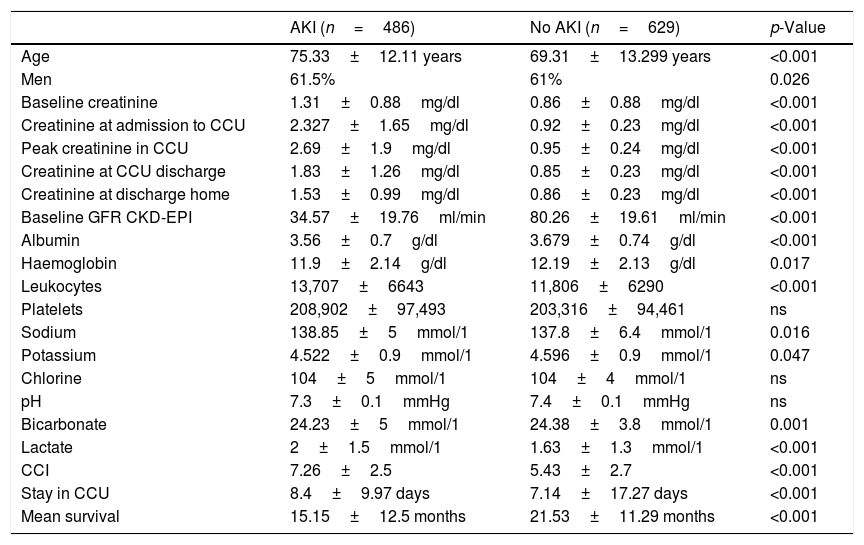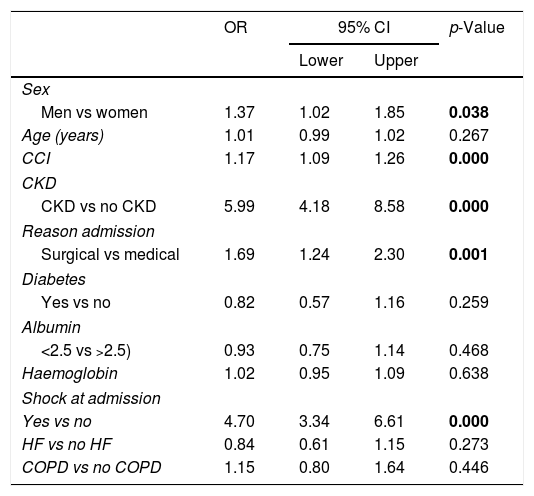The main objective of the study is to perform an analysis on the incidence, predictive variables, and severity of acute kidney injury (AKI) and its impact on the morbidity and mortality of patients in the Resuscitation and Special Care Unit (RSCU) of a regional hospital.
MethodsA retrospective observational study was conducted that included all patients admitted from 1 January 2012 to 1 January 2015 (1115 patients). The follow-up was until 15 July 2015. A descriptive statistical analysis of clinical–epidemiological and analytical variables was carried out. An analysis was then performed AKI in RSCU and mortality, as well as the agreement between the Risk, Injury, Failure, Loss of Kidney Function, and End-stage Kidney Disease (RIFLE)/Acute Kidney Injury Network (AKIN)/Kidney Disease: Improving Global Outcomes (KDIGO) criteria (kappa index). A multivariate logistic regression analysis was performed to select the variables associated with the presentation of AKI in RSCU and a univariate (Kaplan–Meier) and multivariate survival analysis (Cox regression). The statistical analysis was carried out using the statistical package SPSS 21.
ResultsDuring admission to RSCU, 486 patients presented with AKI (43.6%), of which 21% were in stage I, 13.8% in stage II, and in stage III 8.7%. A high level of agreement was observed between the RIFLE/AKIN/KDIGO criteria. The variables that were related to the presence of AKI, are male (OR: 1.37; 95% CI: 1.02–2.30), to high Charlson Comorbidity Index (OR: 1.17; 95% CI: 1.09–1.26), carriers of chronic kidney disease (OR: 5.99; 95% CI: 4.58–8.18), admission due to surgery (OR: 1.69; 95% CI: 1.24–2.30), and shock (OR: 4.70; 95% CI: 3.34–6.61). The probability of survival during admission in RSCU decreases in patients with AKI (HR: 5.44; 95% CI: 1.70–17.39), and as the individual severity index of Liaño increases (HR: 10.29; 95% CI: 3.34–31.76). The probability of survival at the end of follow-up after hospital discharge decreases in patients with AKI (HR: 1.72; 95% CI: 1.14–2.61), as the individual severity index of Liaño increases (HR: 9.6; 95% CI: 5.07–18.20), the Charlson Comorbidity Index >6 (HR: 1.09; 95% CI: 1.03–1.15), low serum albumin <2.5mg/dL (HR: 1.69; 95% CI: 1.13–2.53), age by year >70 years (HR: 1.03; 95% CI: 1.01–1.04), males (HR: 1.38; 95% CI: 1.06–1.79) and carriers of previous chronic kidney disease (HR: 1.56; 95% CI: 1.02–2.38).
ConclusionsThis study shows the presentation of an episode of AKI was an independent factor associated both with mortality during admission to RSCU, and later after hospital discharge. It is necessary to know the risk factors of this complication in order to adopt preventive measures.
El objetivo principal del estudio es analizar la incidencia, las variables predictoras y gravedad del fracaso renal agudo (FRA) y su repercusión en la morbimortalidad de los pacientes de la Unidad de Reanimación y Cuidados Especiales (URCE) de un hospital comarcal.
MétodosEstudio observacional retrospectivo que incluye a todos los pacientes ingresados del 1/1/2012 al 1/1/2015 (1.115 pacientes). El seguimiento fue hasta el 15/07/2015. Se llevó a cabo una estadística descriptiva de variables clinicoepidemiológicas y analíticas. Se realizó el análisis de FRA en URCE y la concordancia entre los sistemas RIFLE/AKIN/KDIGO (índice kappa). Para seleccionar las variables asociadas a la presentación de FRA en URCE, se realizó un análisis de regresión logística multivariante y para el análisis de la repercusión del FRA en la mortalidad, tanto en URCE como al final del seguimiento; se llevó a cabo un análisis de supervivencia univariante (Kaplan–Meier) y multivariante (regresión de Cox). El análisis estadístico se realizó con el paquete estadístico SPSS 21.
ResultadosDurante el ingreso en URCE, 486 pacientes presentaron FRA (43,6%), de los cuales, el 21% se encontraban en estadio i, el 13,8% en estadio ii y el 8,7% en estadio iii. Observamos una elevada concordancia entre los sistemas RIFLE (Risk, Injury, Failure, Loss of Kidney Function, and End-stage Kidney Disease)/AKIN (Acute Kidney Injury Network)/KDIGO (Kidney Disease: Improving Global Outcomes). Las variables que se relacionan con presencia de FRA son varones (OR: 1,37; IC95%: 1,02-2,30), con el índice de comorbilidad de Charlson elevado (OR: 1,17; IC95%: 1,09-1,26), portadores de enfermedad renal crónica (OR: 5,99; IC95%: 4,58-8,18), ingreso por causa quirúrgica (OR: 1,69; IC95%: 1,24-2,30) y shock (OR: 4,70; IC95%: 3,34-6,61). La probabilidad de supervivencia, durante el ingreso en URCE, disminuye en pacientes con FRA (HR: 5,44; IC95%: 1,70-17,39) y según aumenta el índice de severidad individual de Liaño (HR: 10,29; IC95%: 3,34-31,76). La probabilidad de supervivencia, al final del seguimiento, disminuye en pacientes con FRA (HR: 1,72; IC95%: 1,14-2,61), según aumenta el índice de severidad individual de Liaño (HR: 9,6; IC95%: 5,07-18,20), el índice de comorbilidad de Charlson>6 (HR: 1,09; IC95%: 1,03-1,15), la albuminemia<2,5mg/dl (HR: 1,69;IC95%: 1,13-2,53), la edad por año>70 años (HR: 1,03; IC95%: 1,01-1,04), ser varones (HR: 1,38; IC95%: 1,06-1,79) y ser portadores de enfermedad renal crónica previa (HR: 1,56; IC95%: 1,02-2,38).
ConclusionesEn nuestro estudio, la presentación de un episodio de FRA fue un factor asociado de modo independiente, tanto con la mortalidad durante el ingreso en URCE como durante el seguimiento tras el alta hospitalaria. Es necesario conocer los factores de riesgo de esta complicación para adoptar medidas preventivas.












